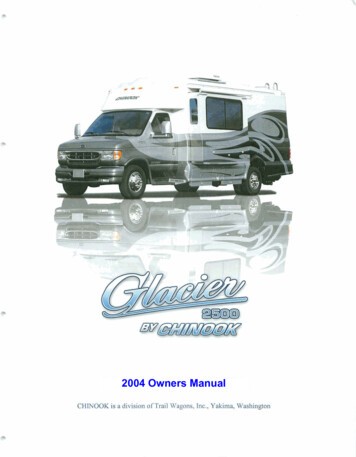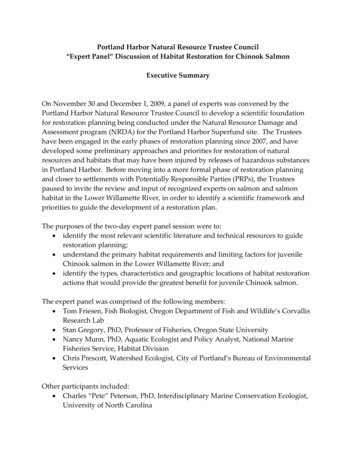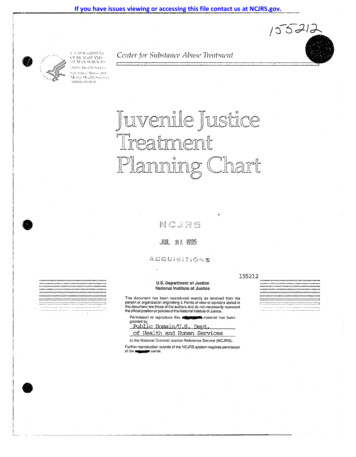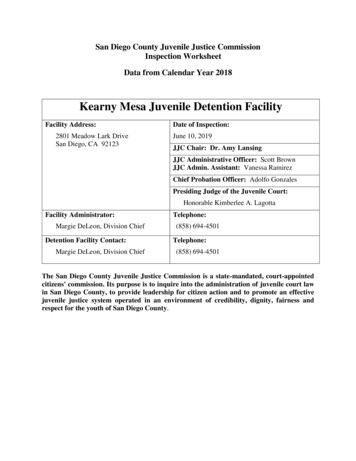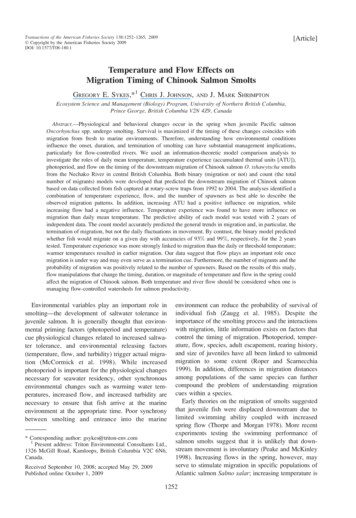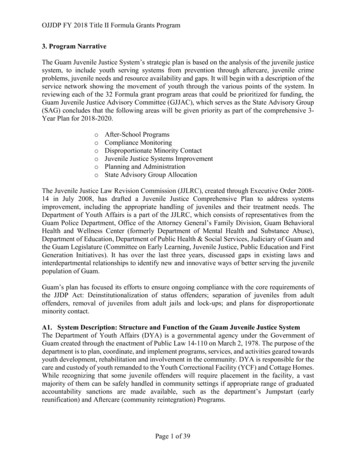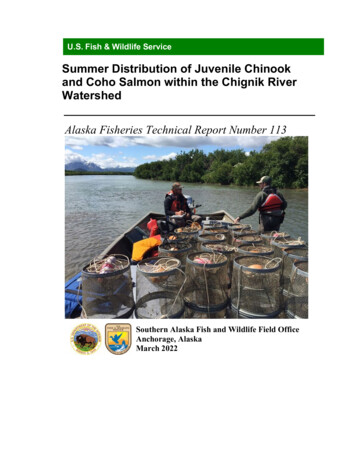
Transcription
U.S. Fish & Wildlife ServiceSummer Distribution of Juvenile Chinookand Coho Salmon within the Chignik RiverWatershedAlaska Fisheries Technical Report Number 113Southern Alaska Fish and Wildlife Field OfficeAnchorage, AlaskaMarch 2022
Alaska Fisheries Technical Report Number 113U.S. Fish and Wildlife Service, March 2022The Alaska Region Fisheries Program of the U.S. Fish and Wildlife Service conductsfisheries monitoring and population assessment studies throughout many areas ofAlaska. Dedicated professional staff located in Anchorage, Fairbanks, and Kenai Fishand Wildlife Offices and the Anchorage Conservation Genetics Laboratory serve as thecore of the Program’s fisheries management study efforts. Administrative and technicalsupport is provided by staff in the Anchorage Regional Office. Our program worksclosely with the Alaska Department of Fish and Game and other partners to conserveand restore Alaska’s fish populations and aquatic habitats. Our fisheries studies occurthroughout the 16 National Wildlife Refuges in Alaska as well as off-Refuges to addressissues of interjurisdictional fisheries and aquatic habitat conservation. Additionalinformation about the Fisheries Program and work conducted by our field offices can beobtained fisheries-reportsThe Alaska Region Fisheries Program reports its study findings through two regionalpublication series. The Alaska Fisheries Data Series was established to providetimely dissemination of data to local managers and for inclusion in agency databases.The Alaska Fisheries Technical Reports publishes scientific findings from singleand multi- year studies that have undergone more extensive peer review and statisticaltesting. Additionally, some study results are published in a variety of professionalfisheries journals.Cover Photo: Seasonal staff setting minnow traps for juvenile salmon in the ChignikRiver watershed, AlaskaDisclaimer: The findings and conclusions in this article are those of the author(s) anddo not necessarily represent the views of the U.S. Fish and Wildlife Service. The useof trade names of commercial products in this report does not constitute endorsementor recommendation for use by the federal government.
Alaska Fisheries Technical Report Number 113U.S. Fish and Wildlife Service, March 2022Summer Distribution of Juvenile Chinook and Coho Salmon within theChignik River WatershedDaniel J. Rinella and Benjamin RichAbstractWe conducted a pilot project in 2016 to better document the basic biology of juvenileChinook Salmon Oncorhynchus tshawytscha and to inform potential future work in theChignik River watershed. We gathered data on their summer distribution, measuredcatch rates at various locations around the watershed to explore the feasibility of a futuretagging study, and assessed the reliability of distinguishing juvenile Chinook Salmonfrom the more abundant Coho Salmon O. kisutch in the field. This work showed that thesummer distribution of juvenile Chinook salmon covered much of the Chignik Riverwatershed, although they appeared to be most consistently found in the lower watershed,from Chignik Lake to Chignik Lagoon. Intensive sampling in these areas suggested thatconcerted effort could feasibly sample hundreds of juvenile Chinook Salmon daily.Genetic analysis indicated that the field crew was able to reliably distinguish juvenileChinook and Coho salmon, based on pigmentation of the adipose fin and the width andspacing of parr marks. This work has improved our understanding of the distribution offish species and life stages around the Chignik River watershed and may facilitate futurestudies of juvenile Chinook Salmon by informing the logistics of capturing andidentifying them.IntroductionThe Chignik River, on the Alaska Peninsula, drains Black and Chignik lakes southwardto the Gulf of Alaska and supports all 5 North American species of Pacific salmonOncorhynchus spp. Sockeye Salmon O. nerka dominate the runs numerically, havehistorically supported subsistence and large-scale commercial fisheries, and have beenthe subject of decades-long research and monitoring programs led by the AlaskaDepartment of Fish and Game (ADF&G) and the University of Washington (UW).Chignik River’s Chinook Salmon O. tshawytscha are rare by contrast and key aspects oftheir biology remain unexamined, including freshwater distribution and relativeabundance.ADF&G opportunistically gathers data on escapement and harvest of Chignik RiverChinook SalmonAuthors: Daniel J Rinella is a fisheries biologist at U.S. Fish and Wildlife Service in Anchorage, Alaska andcan be reached at daniel rinella@fws.gov. Benjamin Rich is currently a graduate student at University ofAlaska Fairbanks and can be reached at barich2@alaska.edu.
Alaska Fisheries Technical Report Number 113U.S. Fish and Wildlife Service, March 2022because their run timing overlaps with that of Sockeye Salmon. Recent annual runsranged from 1,547 to 10,177 fish (1978–2017), with an average of 5,466 (Schaberg et al.2019). Most Chinook Salmon harvest occurs incidentally by commercial purse seinerstargeting Sockeye Salmon in Chignik Lagoon and Chignik Bay, near the mouth of thewatershed. This harvest averaged 1,894 fish (range 208–5,240) and comprised 36% ofthe total run (range 11–72%) (1978–2017; Schaberg et al. 2019). Smaller numbers offish are harvested annually in subsistence and sport fisheries (Schaberg et al. 2019). Runsizes have declined in recent years, and every run since 2006 has been below the longterm average (Schaberg et al. 2019). Runs in 2013, 2017, 2018, 2020, and 2021 run fellbelow ADF&G’s biological escapement goal of 1,300–2,700 fish (Renick 2020;ADF&G Fish Count Data Search ng data suggest that Chinook Salmon spawning distribution within the Chignikwatershed is geographically limited. Prior to this project, ADF&G’s AnadromousWaters Catalog (AWC) documented Chinook spawning only in the Chignik River (i.e.,from the outlet of Chignik Lake downstream to Mensis Point, about 8 km). Ron Lind, aresident of Chignik Lake, reported to us that Chinook Salmon began spawning near hiscabin on Black River around 2008, suggesting a recent expansion.Prior to this project, the AWC contained no records of juvenile Chinook Salmon rearingin the Chignik watershed. Reports on Sockeye Salmon monitoring efforts by ADF&Gand UW, however, provide some information on juvenile distribution. ADF&Gconducted annual Sockeye Salmon smolt trapping on the Chignik River between 1994and 2016 using rotary screw traps.The most recent annual reports show small and variable (i.e., from 25–1,690 fish)annual incidental catches of juvenile Chinook Salmon (Finkle and Ruhl 2009; Loewenand Bradbury 2011; Loewen and Baechler 2015, 2016). These reports also show thatdaily counts tended to be higher during June and July than during May. Beach seiningduring May–July (2010–2015) in Black Lake and Chignik Lagoon, conducted inconjunction with ADF&G’s Sockeye Salmon smolt trapping, captured low numbers ofChinook Salmon smolt during some years but not others (Loewen and Baechler 2016).Smolt trapping by UW indicates that Chinook fry are abundant in Chignik River fromMay through at least August (Ruggerone and Harvey 1994).UW’s beach seine data suggest that many of these fish migrate upstream to ChignikLake during the fall and winter (Ruggerone and Harvey 1994). UW staff have alsocaptured juvenile Chinook Salmon sporadically in Chignik Lake during annual Maythrough August sampling (Westley et al. 2006).ADF&G developed a Chinook Salmon Stock Assessment and Research Plan in 2013 toassess the causes and extent of Alaska’s widespread Chinook Salmon declines over theprior decade. This plan, which focused research efforts on Chignik River ChinookSalmon and Alaska’s eleven other index stocks, recommended stock assessment toestimate annual smolt abundance and, ultimately, allow calculations of marine vsfreshwater survival rates (ADF&G Chinook Research Team 2013). The recommendedwork would use passive integrated transponder (PIT) and coded wire tags to estimatesmolt abundance and marine survival from subsequent adult returns.2
Alaska Fisheries Technical Report Number 113U.S. Fish and Wildlife Service, March 2022We conducted a pilot project in 2016 to collect data in support of potential future workon juvenile Chinook Salmon in the Chignik River. During this project, we gathered dataon the summer distribution of juvenile Chinook Salmon within the Chignik Riverwatershed, measured catch rates at various locations around the watershed to explore thefeasibility of a future tagging study, and assessed the reliability of field characteristicsfor distinguishing juvenile Chinook Salmon from the more abundant Coho Salmon O.kisutch. Despite our focus on Chinook Salmon, we also report data for Coho Salmoncaptured during this effort.Objectives1. Document the summer distribution of juvenile Chinook and Coho salmon at sitesthroughout the Chignik River watershed accessible by jet boat and nominate any newoccurrences of species or life stages to the AWC2. Identify sampling sites, seasonal timing, and sampling methods with the greatest potentialto yield large samples of juvenile Chinook Salmon for any future tagging studies3. Confirm that juvenile Chinook and Coho salmon from the Chignik River watershed canbe reliably distinguished in the fieldStudy areaThe Chignik Watershed is a major salmon system on the Alaska Peninsula that drainssouthward into the Gulf of Alaska. The watershed contains two large lakes connected byrivers, Black Lake and Chignik Lake (Figure 1), which support genetically distinct runsof Sockeye Salmon. The Black River drains from Black Lake, which is surrounded bylow-lying tundra near the center of the Peninsula, into Chignik Lake, a much deeper andnarrower lake surrounded by mountains.The Chignik River flows from the southern end of Chignik Lake (near the Village ofChignik Lake) into the brackish Chignik Lagoon. Chignik Lagoon and Chignik Bay,separated by a narrow spit, support most of the commercial fishing activity in the area.MethodsTo address objective 1, we sampled juvenile Chinook and Coho salmon throughout theChignik River watershed late May‒late July 2016, focusing our efforts on 5 zones: (1)Chignik Lagoon,(2) Chignik River, (3) Chignik Lake including tributaries, (4) BlackRiver including tributaries, and (5) Black Lake including tributaries (Figure 1). Oursampling effort focused disproportionately on the Chignik River (Table 1) as wepresumed this to be the primary spawning and rearing habitat and because wind-drivenchop on Chignik Lagoon and Chignik Lake often prevented boat access to other parts ofthe watershed. Our primary gear was Gee- style minnow traps (Table 1) baited withcommercially cured salmon roe and soaked for approximately 1 hour. In flowing water,we typically set minnow traps in areas of low current (e.g., pools, alcoves, behindboulders) while in the lagoon and lakes we set along the margins in water 30–100 cm3
Alaska Fisheries Technical Report Number 113U.S. Fish and Wildlife Service, March 2022deep. We also sampled with a mini fyke net (12.3-m lead, set perpendicular to shore) inChignik Lake and Chignik River and a Smith-Root LR-24 backpack electrofisher inCucumber Creek (Table 1). During each sampling event, we used Pollard et al. (1997) toidentify all salmonids and counted all fish by species.For objective 2, we focused intensive sampling on the areas and techniques that weexpected would yield the largest samples of juvenile Chinook salmon. This effort, whichbegan in late July 2016 and extended through the end of sampling in late August,consisted of beach seining (30-m long, 10-minute tows parallel to shore) in ChignikLake and Chignik Lagoon and baited minnow trap sets in Black River and Chignik River(Table 1). Because our earlier sampling indicated that catch rates were maximized indeeper water with stronger current than normally fished with minnow traps, we riggedthe traps used in this effort in gangs of 4, tethered them to a 5-kg mushroom anchormarked by a buoy, and set them in areas with coarse substrate and moderate flowbetween 1 and 2 m deep.For objective 3, we collected fin clips from a subsample of 404 fish identified in thefield as juvenile Chinook or Coho salmon for genetic species confirmation by theUSFWS Conservation Genetics Lab, preferentially selecting specimens that weredifficult to distinguish. Prior to release, we also photographed the left side of most fishfor future reference (n 191 Chinook Salmon and 187 Coho Salmon).ResultsWe caught juvenile Chinook Salmon in the Chignik Lagoon, Chignik River, ChignikLake, Black River and in roughly half of the tributaries sampled (Table 1). We caughtjuvenile Coho Salmon at every site except a few tributaries to Black Lake and BlackRiver.These collections, and some incidental observations, led to several AWC nominationsfor species and life stages that had not been previously cataloged. We nominatedChignik Lake, Chignik River, Black River, Alec River, Bearskin Creek, ChiaktuakCreek, and Crater Creek for Chinook Salmon rearing. We confirmed Ron Lind’s reportof Chinook Salmon spawning in Black River near his cabin and made that nominationas well. We also nominated Chignik and Black lakes, Chignik and Black rivers, and 6tributary streams for Coho Salmon rearing, 7 water bodies for Dolly Varden presence,and Chignik Lake and Chignik River for Sockeye Salmon spawning and rearing.Our intensive sampling suggested that sampling Chignik Lagoon, Chignik Lake, andChignik River during July and August had potential to produce large samples ofjuvenile Chinook salmon. August minnow trapping (n 216) in Chignik Riverproduced 2.9 fish per 1-hour soak, July beach seining (n 2) in Chignik Lagoonproduced 18 fish per 10-minute tow, and August beach seining (n 38) in Chignik Lakeproduced 11.9 fish per tow (Table 1).Genetic analyses of 404 fish identified in the field as juvenile Chinook or Coho salmonindicated that 95.6% were identified correctly while 2.7% were misidentified (genetic4
Alaska Fisheries Technical Report Number 113U.S. Fish and Wildlife Service, March 2022identification was inconclusive for 1.7%).DiscussionThis work showed that the summer distribution of juvenile Chinook salmon coveredmuch of the Chignik River watershed, although they appeared to be most consistentlyfound in the lower watershed, from Chignik Lake to Chignik Lagoon. Our intensivesampling also suggested that they were most abundant in this area, at least during Julyand August, suggesting that the lower watershed may be the primary summer rearingarea. Intensive sampling also suggested that concerted effort in the lower watershedcould feasibly sample hundreds of juvenile Chinook Salmon daily.Genetic analysis indicated that the field crew was able to reliably distinguish juvenileChinook and Coho salmon. The most reliable diagnostic trait was the pigmentation ofthe adipose fin, with Chinook Salmon having an opaque chromatophore-free “window”and Coho Salmon having chromatophores throughout (Dahlberg and Phinney 1967;Pollard et al. 1997). With practice, the crew could quickly distinguish salmon speciesbased on their overall appearance, which we assumed was based on differences in thewidth and spacing of parr marks.As a follow-up analysis, we measured Chinook and Coho salmon parr mark width andspacing using the photographic archive of genetically confirmed specimens (Figure 2).Working along the lateral line, we digitally measured the width (in pixels) of each of thefirst 4 parr marks lying completely behind the gill plate and the 3 gaps between them (inaddition to fork length of each fish) and expressed the width of each parr mark and gapas a proportion of the respective fish’s fork length. We then measured pairwisecorrelations between all 7 features and used those that were uncorrelated (r 0.60) aspredictors in a linear discriminant function to determine if they could accurately assignspecies. In this model, the species of each individual (i) was assigned based on 3predictors: the width of the first parr mark, the space between parr marks 1 and 2, andthe space between parr marks 3 and 4:Speciesi Parr 1xi Space 1 2xi Space 3 4xiWe fit the model to a randomly selected 75% of the data, used the resulting model toassign species to the remaining 25%, and repeated 1,000,000 times to calculate mean(and 95th percentile) accuracy rate. We used the function lda in package MASS using R(v.4.0.2, R Core Team 2020) to fit the model and used the predict function forcalculating posterior probabilities. The model assigned Chinook Salmon with 74% (95thpercentile 62–85) accuracy and Coho Salmon with 81% (95th percentile 0.68–0.92)accuracy, indicating that parr mark width and spacing alone could correctly assignspecies most of the time.This work has improved our understanding of the distribution of fish species and lifestages around the Chignik River watershed. Additionally, it may facilitate future studiesof juvenile Chinook Salmon within the watershed by informing the logistics of capturingand identifying them.5
Alaska Fisheries Technical Report Number 113U.S. Fish and Wildlife Service, March 2022AcknowledgmentsAdam Grunwald served as the field crew lead and made digital measurements of parrmark width and spacing. Field housing and logistical support were provided byADF&G’s Division of Commercial Fisheries and UW’s Alaska Salmon Program. Inparticular, we thank Dawn Wilburn, Lucas Stumpf, and the rest of the ADF&G weircamp plus Jeff Baldock and Dean Freundlich from UW’s field camp. We also thank theresidents of Chignik Lake for their help and hospitality and Ron Lind for sharing hisknowledge of local salmon populations. Editorial review of this report was provided byJonathon Gerken and Mike Buntjer.6
Alaska Fisheries Technical Report Number 113U.S. Fish and Wildlife Service, March 2022ReferencesADF&G Chinook Salmon Research Team. 2013. Chinook Salmon stock assessmentand research plan, 2013. Alaska Department of Fish and Game, SpecialPublication No. 13-01, Anchorage.Dahlberg, M. L., and D. E. Phinney. 1967. The use of adipose fin pigmentation fordistinguishing between juvenile Chinook and Coho salmon in Alaska. Journal ofthe Fisheries Research Board of Canada 24:209–211.Finkle, H., and D. Ruhl. 2009. Sockeye Salmon smolt investigations on the ChignikRiver, 2008. Alaska Department of Fish and Game, Fishery Data Series No. 0916, Anchorage.Loewen, M. and N. Baechler. 2015. The 2014 Chignik River Sockeye Salmon smoltoutmigration: an analysis of the population and lake rearing conditions. AlaskaDepartment of Fish and Game, Fishery Data Series No. 15-02, Anchorage.Loewen, M., and N. Baechler. 2016. The 2015 Chignik River Sockeye Salmon smoltoutmigration: an analysis of the population and lake rearing conditions. AlaskaDepartment of Fish and Game, Fishery Data Series No. 16-12, Anchorage.Loewen, M. and J. Bradbury. 2011. Sockeye Salmon smolt investigations on theChignik River, 2010. Alaska Department of Fish and Game, Fishery Data SeriesNo. 11-26, Anchorage.Pollard, W. R., G. F. Hartman, C. Groot, and P. Edgell. 1997. Field identification ofcoastal juvenile salmonids. Harbour Publishing, Canada.Renick, R. L. 2020. Chignik Management Area salmon annual management report,2019.Alaska Department of Fish and Game, Fishery Management Report No. 20-11,Anchorage.Ruggerone, G. T. and C. J. Harvey. 1994. Age-specific use of habitat by juvenile Cohoand other salmonids in the Chignik Lakes watershed, Alaska. Proceedings of the1994 Northeast Pacific Chinook and Coho Salmon Workshop, Eugene, OR.Schaberg, K. L., M. B. Foster, and A. St. Saviour. 2019. Review of salmon escapementgoals in the Chignik Management Area, 2018. Alaska Department of Fish andGame, Fishery Manuscript Series No. 19-02, Anchorage.Westley, P. A. H., B. E. Chasco, and R. Hilborn. 2006. Chignik salmon studies:investigations of salmon populations, hydrology, and limnology of the ChignikLakes, Alaska, during 2004 and 2005. Annual report to the National MarineFisheries Service, University of Washington, School of Aquatic and FisherySciences7
Alaska Fisheries Technical Report Number 113U.S. Fish and Wildlife Service, March 2022Table 1. Sampling effort and catch, by sampling location, month and gear type. Effort isexpressed in 1-hour sets for minnow trapping, by the number of 10-minute tows for beachseining, by number of sets (and cumulative hours) for mini fyke netting, and the cumulativeshock time for electrofishing. Catch rates are not necessarily comparable across rows due todifferences in sampling gear and effort.ZoneLocationChignik Chignik LagoonLagoon Chignik LagoonChignik RiverChignik LakeBlack RiverBlack LakeChignik LagoonChignik RiverChignik RiverChignik RiverChignik RiverChignik RiverBearskin CreekChignik LakeChignik LakeChignik LakeChignik LakeClark RiverClark RiverCucumberCreekCucumberCreekHome CreekHome CreekBlack RiverBlack RiverBlack RiverChiatkuakCreekWest ForkAlec RiverBlack LakeCrater CreekFan CreekMilk CreekMonthGear innow trapbeach seinebeach seineminnow trapmini fyke netminnow trapminnow trapminnow trapminnow trapmini fyke netminnow trapminnow trapbeach seineminnow trapminnow trapminnow trap54223281 (9 hours)43168216305 (88 5MayJuneJuneJulyAugustJuneminnow trapminnow trapminnow trapminnow trapminnow trapminnow JuneJulyJuneJuneJuneminnow trapminnow trapminnow trapminnow trapminnow trapminnow trap52320333060100052210008
Alaska Fisheries Technical Report Number 113U.S. Fish and Wildlife Service, March 2022Figure 1. Map of Chignik Watershed showing all cataloged anadromous waters and pointson water bodies cataloged for Chinook and Coho salmon. The sampling zones used in thisstudy are outlined in black: (1) Chignik Lagoon, (2) Chignik River, (3) Chignik Lake andtributaries, (4) Black River and tributaries, (5) Black Lake and tributaries.9
Alaska Fisheries Technical Report Number 113U.S. Fish and Wildlife Service, March 2022Figure 2. Examples of field photographs of juvenile Chinook (top) and Coho (bottom)salmon used to measure width and spacing of parr marks. The yellow box outlines the 4parr marks and 3 gaps used in our analysis, which showed that Chinook Salmon hadwider parr marks and narrower gaps (as a proportion of body length) than Coho Salmon.10
Alaska Fisheries Data Series . was established to provide timely dissemination of data to local managers and for inclusion in agency databases. The . Alaska Fisheries Technical Reports . publishes scientific findings from single and multi- year studies that have undergone more extensive peer review and statistical testing.
